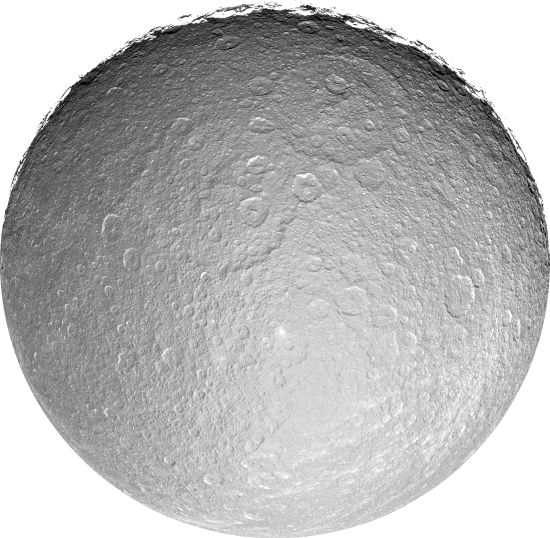rhea
Rhea is the second largest moon of Saturn, but with a mean radius of 475 miles (764 kilometers) it is less than a third the radius of Saturn's largest moon, Titan. Rhea is a small, cold, airless body that is very similar to sister moons Dione and Tethys. As with the other two moons, Rhea is tidally locked in phase with its parent — one side always faces toward Saturn — as it completes its 4.5-Earth-day orbit around the planet. Rhea's surface temperatures are also similar to Dione and Tethys, being roughly as warm as -281 degrees Fahrenheit (-174 degrees Celsius) in sunlit areas and ranging down to -364 degrees Fahrenheit (-220 degrees Celsius) in shaded areas. Also like Dione and Tethys, Rhea has a high reflectivity (or geometric albedo) suggesting a surface composition largely of water ice, which behaves like rock in Rhea's temperature range.
Rhea's density of 1.233 times that of liquid water suggests that Rhea is three quarters ice and one quarter rock. Cassini spacecraft measurements from a close encounter showed a moment of inertia about its axis (a measure of how difficult it is to change its rotation) of a higher value than what would be expected if Rhea has a rocky core. Thus, it is thought that Rhea is composed of a homogenous mixture of ice and rock — a frozen dirty snowball.
Rhea, at a distance of 327,500 miles (527,000 kilometers), is farther away from Saturn than Dione and Tethys, and because of this Rhea does not receive ample tidal variation from Saturn to cause internal heating. This has an important effect. Both Dione and Tethys have more areas of smooth plains than Rhea. Such plains are probably areas where liquid water reached the surface and ponded in depressions such as craters, forming flat surfaces before refreezing and thus erasing existing craters. The lesser internal warmth at Rhea could have resulted in fewer erasures or there could have been more bombardment on Rhea. Whatever the reason, Rhea is more heavily cratered than Dione and Tethys.

